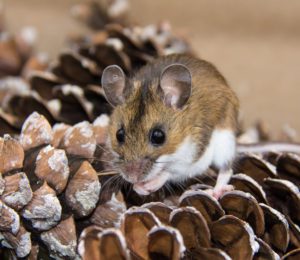Mice are one of the most common nuisance wildlife problems, especially in the approaching fall and winter seasons. They prefer dark, sheltered areas that are close to a dependable food supply, and since mice aren’t hibernators, the warmth and sustenance offered by human living spaces make your home or business an ideal place to harbor during the cold months.
While they may seem small and harmless, mice are capable of causing a great deal of damage to your property. In addition to invading your kitchen and pantry, mice are known for gnawing through wood, cardboard, and a variety of other materials to help shave down and maintain their teeth which are in a
Signs of a Mouse Problem
The following signs may indicate the presence of a mouse infestation:
- Feces or Urine Stains – Mice leave small droppings (no larger than 6mm) with pointed ends wherever they travel. Check in cabinets and drawers, on shelves, in the corners of rooms, and near food sources.
- Rub Marks – Check along baseboards and at the bottom of walls for dark marks. Mice tend to hug the edges of walls when they travel, and the dirt and oil from their fur can rub off and cause staining.
- Burrow Entrances – Mice are able to fit through an opening as small as ¼ of an inch, so their burrow entrances may be difficult to identify. Examine corners, baseboards, and foundations for holes. These gaps will also typically be free of dust, but full of droppings.
- Noise – Listen for shuffling, scratching, squeaking, or chewing noises, especially at night. Mice are nocturnal and will make the most noise during dark hours.
- Chewing – Look for chewing along baseboards, cabinets, and doors as well as in boxes where you store dry goods. Mice also leave shavings in areas where they gnaw.
- Mouse Sighting – While they are most active at night and averse to light, it is possible you may encounter a mouse during the day. If you spot one, it is a good indication that there are a number of mice living in your home or business.
Preventative Measures: What To Do If You Have A Mouse Problem
To keep mice from becoming a problem in your home or business, consider implementing the following preventative measures:
- Make sure your garbage cans and recycling bins are sealed tightly.
- Any cracks or gaps in your foundation, siding, and window frames that are a quarter of an inch or larger should be closed using cement, metal, or any substance impervious to gnawing.
- Keep food sealed in airtight containers.
- Sanitation is a key component to controlling a mouse issue. Keeping your home clean will reduce food sources, making your property a less appealing living space. Wipe up any spills or crumbs, and wash beneath the refrigerator and stove regularly.
If you notice signs of a mouse presence in your house, contact a wildlife control technician right away. One female mouse is capable of producing up to 48 young per year, so addressing the issue as soon as it arises will keep the infestation from increasing. A licensed pest specialist will inspect your home or business thoroughly, identify mouse access points and areas of harborage, and offer an effective solution for ridding your property of rodents and preventing future problems. A mouse population will only increase and cause more and more damage, so don’t wait to remove them from your home.


